In the past, people lived in small, isolated communities where artisans and farmers bartered goods and services among themselves. Distribution was limited to how far people could walk, and advertising to how loud they could shout. Today, things are different. Our ways of communicating have taken new forms. As you go through the City, you see advertisements painted on walls, posters of election campaigns, hoardings that hide heritage buildings or that become facades of contemporary buildings. The city has become our canvas for communication.
Signages, messages and markers
We could categorise these ways of communication into Signage, Messages and Markers. Signages are the traffic signs, signs showing directions to shops or to restaurants and road names. The Messages comprise of Cinema posters, Advertisement hoardings and election campaign posters. Markers are parts of the communication system that help us navigate through our city. These are Shop names, Building names/numbers, the Traffic junctions/islands and Historical monuments/ Landmarks. They also create an identity of the street and the neighbourhood. Markers could also be flagposts which signify the presence of a certain community or sometimes define an activity within a neighbourhood.
Revenue for the municipality
These are just a few of the many ways we have begun to communicate within our urban habitats. Some streets in the city tend to have a greater number of hoardings. This is because certain parts of the city and certain street junctions have larger vehicular and pedestrian traffic and become lucrative locations for a hoarding . The Municipal Corporation owns some of these hoarding locations. So, the urban landscape and its visual language becomes enmeshed with the revenue generating mechanisms of the local municipality.
Cinema poster on wall
You see a Cinema poster on a compound wall. There is a garland over the poster, which probably has been put there by a passer-by or by a local resident from the area.

Cinema poster at Bannerghatta road
It could be that it is a garland that he has taken away from a shrine because he has put there a fresh garland. So, he has this garland with him and he thinks that instead of throwing it away, he may as well put it here. Or, it is absolute adoration for the cinema hero that made the resident buy the garland. We don’t know. As passers-by, we can interpret this phenomenon in different ways.
The Astrologer Sign
Our streets are also places of exchange. You find a vendor selling his goods or someone selling a service. Sometimes, it’s a cobbler by the tree, sometimes, a keymaker and sometimes a barber with his customer on a high chair. In the image below, there is the astrologer signboard in the middle of the footpath.
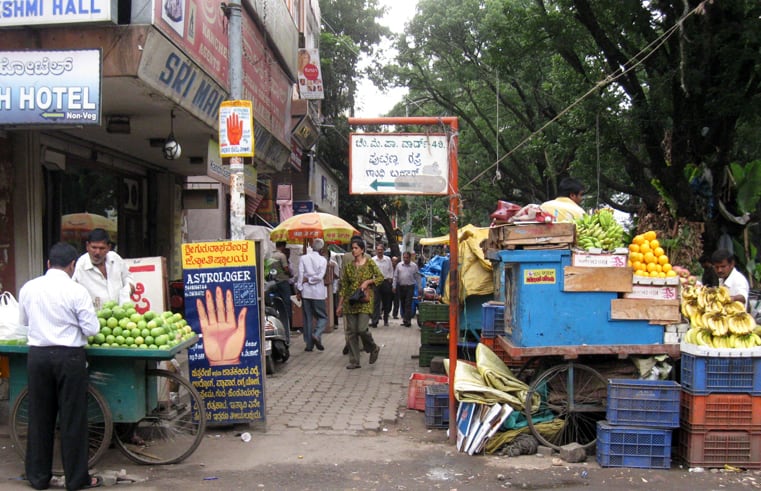
On Gandhi Bazaar main road in Basavanagudi
Everyone selling goods or services has a way to communicate to the walker in the city. So, when one discusses the city as a communication network, it is not just about the large hoardings that are put up in the city, it is also about reading the small signs that are everywhere.
Bangalore Central mall
Sometimes, festivals within the city create a new set of messages. In the image below, the Bangalore Central mall at J.P.Nagar is decorated for the Diwali festival. It attempts to attract pedestrians towards itself.
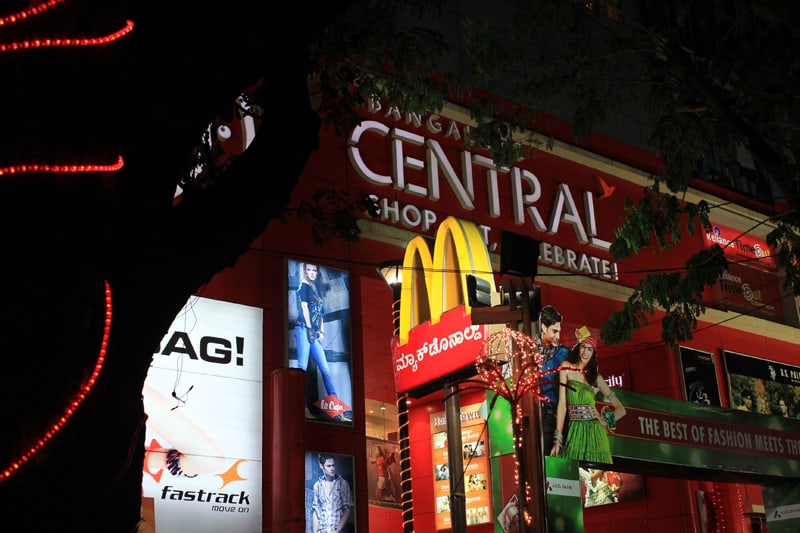
Bangalore Central Mall at J.P.Nagar at Diwali time
The design of the mall has utilised all available space to its maximum with the approach becoming abrupt. The building sits starkly onto the street. However, the festival of Diwali gives the mall an opportunity to create that sense of approach. The lighting on the trees helps attract people approaching the mall from either side of the street.
Mysore sandal soap
This kind of advertisement goes up only when the shop shutter comes down.

The Mysore Sandal advertisement at D.V.G.road in Basavanagudi
Besides, there are other messages pasted on the rolling metal shutter of the shop which the shopowner has not given permission for. On the other hand, the television has taken the advertisement to the home. This changes the way advertisement works in the city. Suddenly, everything is sucked into the home and into the Television. If the TV had not come into our lives, would there have been even more hoardings on our streets and in our cityscapes?
Adam’s Furnishers
This signboard indicates a shop that has been in this location for many years.
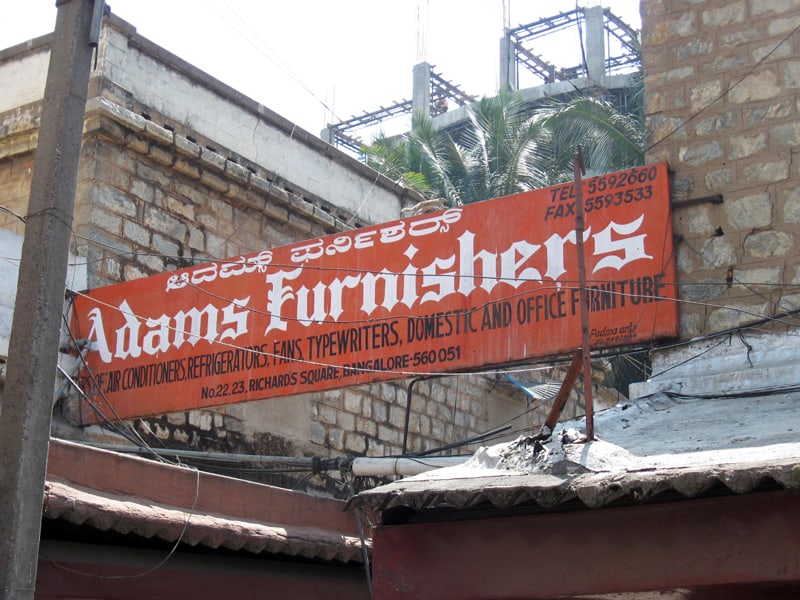
Adam’s Furnishers at Richard’s Square in Shivajinagar
The shopowners seem to have retained the old-fashioned signboard. The shop and the place have a historicity linked to them. Here, the shop sign is a special sign because it has historical meaning to it. The sign itself is not necessarily fifty years old but retains the old-world flavour in its typography.
Basavanagudi post office
The post office is on one side of the road. There is a large signboard on the opposite side of the road pointing to the post office.

The Signboard for Basavanagudi Post office
Why did this sign become necessary? Perhaps, the need for the sign arose when the tree in front of the Post office building grew wider and taller and hid the building to a great extent.
Sacred space in Lalbagh gardens
For us, sacred trees such as the Peepul tree or the Banyan tree define a sacred space within the urban environment as they have a religious association.
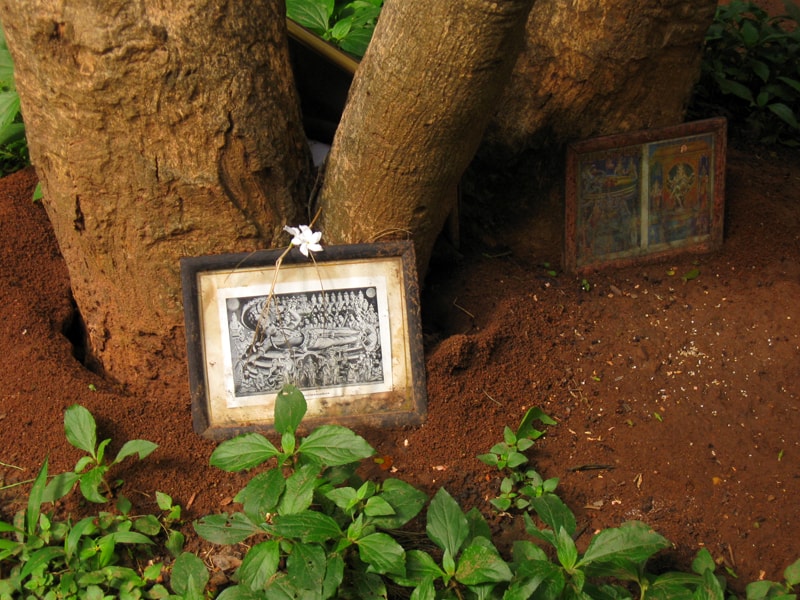
The Shrine as a Marker in Lalbagh gardens
Here, at the Lalbagh gardens, the picture of a deity is placed at a tree and it begins to be worshipped with passers-by placing fresh flowers here every day. The tree and the picture become a marker on the street or in the public space.
House on Bugle rock road
A house number or a symbol on a front door can become a marker too.
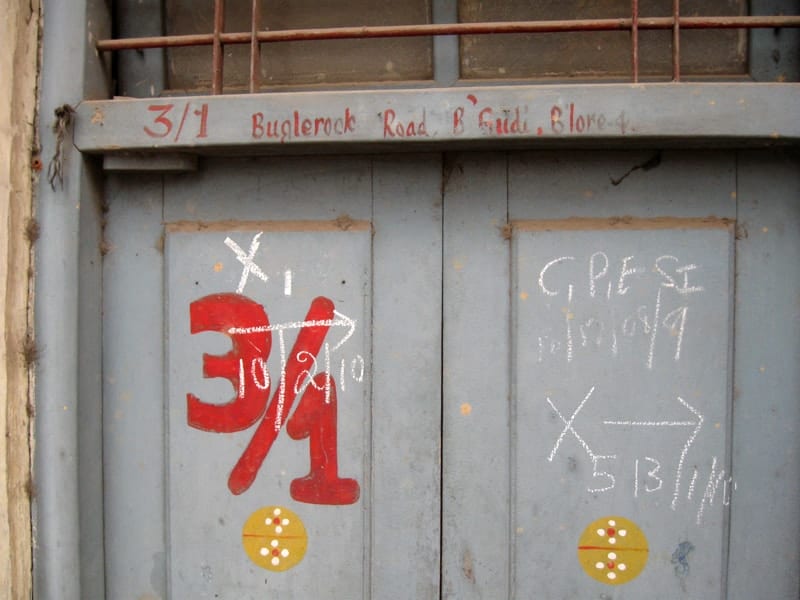
a House door on Bugle rock road in Basavanagudi
In the older neighbourhoods of Bangalore, houses often have the year of construction written on the façade. It becomes a part of the collective memory of the street.
The Life of the City
There are different ways in which you may experience the city of Bangalore – as you walk through Bugle rock road and pass by the door with its changed house number; as you stop at the tree shrine at Lalbagh; as your eyes register the old-fashioned signboard of Adam’s Furnishers; as the Mysore Sandal soap ad catches your attention; as you read the Astrologer’s sign at Gandhi Bazaar or can’t but help see the garland over the cinema poster on Bannerghatta road. Sometimes, it is possible to read the Life of the city in its Communication networks.